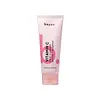What's inside
What's inside
 Key Ingredients
Key Ingredients

 Benefits
Benefits

 Concerns
Concerns

 Ingredients Side-by-side
Ingredients Side-by-side

Water
Skin ConditioningGlycerin
HumectantStearic Acid
CleansingMyristic Acid
CleansingLauric Acid
CleansingPotassium Hydroxide
BufferingPalmitic Acid
EmollientCoco-Glucoside
CleansingGlyceryl Stearate
EmollientPolyquaternium-7
Limonene
PerfumingAcrylates/C10-30 Alkyl Acrylate Crosspolymer
Emulsion StabilisingSodium Cocoyl Isethionate
CleansingArachidic Acid
CleansingDisodium EDTA
1,2-Hexanediol
Skin ConditioningCitrus Limon Peel Oil
MaskingOleic Acid
EmollientSodium Benzoate
MaskingCitrus Aurantium Dulcis Peel Oil
MaskingQuillaja Saponaria Bark Extract
CleansingCitric Acid
BufferingAscorbic Acid
AntioxidantWater, Glycerin, Stearic Acid, Myristic Acid, Lauric Acid, Potassium Hydroxide, Palmitic Acid, Coco-Glucoside, Glyceryl Stearate, Polyquaternium-7, Limonene, Acrylates/C10-30 Alkyl Acrylate Crosspolymer, Sodium Cocoyl Isethionate, Arachidic Acid, Disodium EDTA, 1,2-Hexanediol, Citrus Limon Peel Oil, Oleic Acid, Sodium Benzoate, Citrus Aurantium Dulcis Peel Oil, Quillaja Saponaria Bark Extract, Citric Acid, Ascorbic Acid
Water
Skin ConditioningSodium Laurylglucosides Hydroxypropylsulfonate
CleansingGlycerin
HumectantSodium Methyl Cocoyl Taurate
CleansingCocamidopropyl Hydroxysultaine
CleansingSodium Chloride
MaskingSorbitol
HumectantSodium Lauryl Glucose Carboxylate
CleansingLauryl Glucoside
CleansingCalendula Officinalis Flower Extract
MaskingChamomilla Recutita Flower Extract
MaskingYucca Schidigera Root Extract
Skin ConditioningSaponaria Officinalis Extract
Skin ConditioningLeuconostoc/Radish Root Ferment Filtrate
AntimicrobialHydrolyzed Quinoa
Skin ConditioningLavandula Angustifolia Oil
MaskingLavandula Hybrida Oil
EmollientPelargonium Graveolens Flower Oil
MaskingPogostemon Cablin Leaf Oil
MaskingAnthemis Nobilis Flower Oil
MaskingCymbopogon Martini Oil
MaskingAbies Sibirica Oil
MaskingGluconolactone
Skin ConditioningPotassium Sorbate
PreservativeSodium Benzoate
MaskingCoconut Acid
CleansingSodium Citrate
BufferingCitric Acid
BufferingSorbic Acid
PreservativeLinalool
PerfumingWater, Sodium Laurylglucosides Hydroxypropylsulfonate, Glycerin, Sodium Methyl Cocoyl Taurate, Cocamidopropyl Hydroxysultaine, Sodium Chloride, Sorbitol, Sodium Lauryl Glucose Carboxylate, Lauryl Glucoside, Calendula Officinalis Flower Extract, Chamomilla Recutita Flower Extract, Yucca Schidigera Root Extract, Saponaria Officinalis Extract, Leuconostoc/Radish Root Ferment Filtrate, Hydrolyzed Quinoa, Lavandula Angustifolia Oil, Lavandula Hybrida Oil, Pelargonium Graveolens Flower Oil, Pogostemon Cablin Leaf Oil, Anthemis Nobilis Flower Oil, Cymbopogon Martini Oil, Abies Sibirica Oil, Gluconolactone, Potassium Sorbate, Sodium Benzoate, Coconut Acid, Sodium Citrate, Citric Acid, Sorbic Acid, Linalool
 Reviews
Reviews

Ingredients Explained
These ingredients are found in both products.
Ingredients higher up in an ingredient list are typically present in a larger amount.
Citric Acid is an alpha hydroxy acid (AHA) naturally found in citrus fruits like oranges, lemons, and limes.
Like other AHAs, citric acid can exfoliate skin by breaking down the bonds that hold dead skin cells together. This helps reveal smoother and brighter skin underneath.
However, this exfoliating effect only happens at high concentrations (20%) which can be hard to find in cosmetic products.
Due to this, citric acid is usually included in small amounts as a pH adjuster. This helps keep products slightly more acidic and compatible with skin's natural pH.
In skincare formulas, citric acid can:
While it can provide some skin benefits, research shows lactic acid and glycolic acid are generally more effective and less irritating exfoliants.
Most citric acid used in skincare today is made by fermenting sugars (usually from molasses). This synthetic version is identical to the natural citrus form but easier to stabilize and use in formulations.
Read more about some other popular AHA's here:
Learn more about Citric AcidGlycerin is already naturally found in your skin. It helps moisturize and protect your skin.
A study from 2016 found glycerin to be more effective as a humectant than AHAs and hyaluronic acid.
As a humectant, it helps the skin stay hydrated by pulling moisture to your skin. The low molecular weight of glycerin allows it to pull moisture into the deeper layers of your skin.
Hydrated skin improves your skin barrier; Your skin barrier helps protect against irritants and bacteria.
Glycerin has also been found to have antimicrobial and antiviral properties. Due to these properties, glycerin is often used in wound and burn treatments.
In cosmetics, glycerin is usually derived from plants such as soybean or palm. However, it can also be sourced from animals, such as tallow or animal fat.
This ingredient is organic, colorless, odorless, and non-toxic.
Glycerin is the name for this ingredient in American English. British English uses Glycerol/Glycerine.
Learn more about GlycerinSodium Benzoate is a preservative. It's used in both cosmetic and food products to inhibit the growth of mold and bacteria. It is typically produced synthetically.
Both the US FDA and EU Health Committee have approved the use of sodium benzoate. In the US, levels of 0.1% (of the total product) are allowed.
Sodium benzoate works as a preservative by inhibiting the growth of bacteria inside of cells. It prevents the cell from fermenting a type of sugar using an enzyme called phosphofructokinase.
It is the salt of benzoic acid. Foods containing sodium benzoate include soda, salad dressings, condiments, fruit juices, wines, and snack foods.
Studies for using ascorbic acid and sodium benzoate in cosmetics are lacking, especially in skincare routines with multiple steps.
We always recommend speaking with a professional, such as a dermatologist, if you have any concerns.
Learn more about Sodium BenzoateWater. It's the most common cosmetic ingredient of all. You'll usually see it at the top of ingredient lists, meaning that it makes up the largest part of the product.
So why is it so popular? Water most often acts as a solvent - this means that it helps dissolve other ingredients into the formulation.
You'll also recognize water as that liquid we all need to stay alive. If you see this, drink a glass of water. Stay hydrated!
Learn more about Water